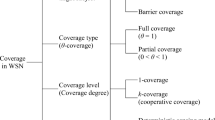Abstract
Sensing devices can be deployed to form a network for monitoring a region of interest. This paper investigates detection of a target traversing the region being monitored by using collaborative target detection algorithms among the sensors. The objective of the study is to develop a low cost sensor deployment strategy to meet a performance criteria. The paper defines a path exposure metric as a measure of goodness of deployment. It then gives a problem formulation for the random sensor deployment and defines cost functions that take into account the cost of single sensors and the cost of deployment. A sequential sensor deployment approach is then developed. The paper illustrates that the overall cost of deployment can be minimized to achieve the desired detection performance by appropriately choosing the number of sensors deployed in each step of the sequential deployment strategy.
Similar content being viewed by others
References
S. Baase and A.V. Gelder, Computer Algorithms: Introduction to Design and Analysis (Addison-Wesley, Reading, MA, 2000).
R.R. Brooks and S.S. Iyengar, Multi-Sensor Fusion: Fundamentals and Applications with Software (Prentice Hall, New York, 1998).
K. Chakrabarty, S.S. Iyengar, H. Qi and E. Cho, Grid coverage for surveillance and target location in distributed sensor networks, IEEE Transactions on Computers 51(12) (December 2002) 1448–1453.
T. Clouqueur, P. Ramanathan, K.K. Saluja and K.-C. Wang, Value-fusion versus decision-fusion for fault-tolerance in collaborative target detection in sensor networks, in: Proceedings of the 4th Ann. Conf. on Information Fusion (August 2001) pp. TuC2/25–TuC2/30.
S.S. Dhillon, K. Chakrabarty and S.S. Iyengar, Sensor placement for effective grid coverage and surveillance, in: Workshop on Signal Processing, Communications, Chaos and Systems, Newport, RI (2002).
M. Hata, Empirical formula for propagation loss in land mobile radio services, IEEE Transactions on Vehicular Technology 29 (August 1980) pp. 317–325.
S. Meguerdichian, F. Koushanfar, M. Potkonjak and M. Srivastava, Coverage problems in wireless ad-hoc sensor networks, in: Proceedings of INFOCOM (April 2001) pp. 1380–1387.
S. Meguerdichian, F. Koushanfar, G. Qu and M. Potkonjak, Exposure in wireless ad-hoc sensor networks, in: Proceedings of MOBICOM (July 2001) pp. 139–150.
S. Meguerdichian, S. Slijepcevic, V. Karayan and M. Potkonjak, Localized algorithms in wireless ad-hoc networks: Location discovery and Sensor exposure, in: Proceedings of MOBIHOC (October 2001) pp. 106–116.
Sensor Information Technology Website, http: //www.darpa. mil/ito/research/sensit/index.html
P. Varshney, Distributed Detection and Data Fusion (Springer, New York, 1996).
Y. Zou and K. Chakrabarty, A practical sensor deployment strategy based on virtual forces, in: Proceedings of IEEE INFOCOM Conference (2003), to appear.
Author information
Authors and Affiliations
Rights and permissions
About this article
Cite this article
Clouqueur, T., Phipatanasuphorn, V., Ramanathan, P. et al. Sensor Deployment Strategy for Detection of Targets Traversing a Region. Mobile Networks and Applications 8, 453–461 (2003). https://doi.org/10.1023/A:1024596016427
Issue Date:
DOI: https://doi.org/10.1023/A:1024596016427




